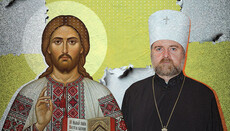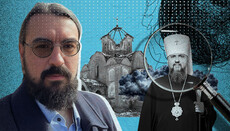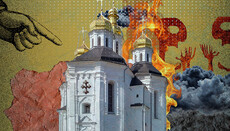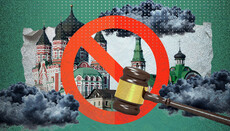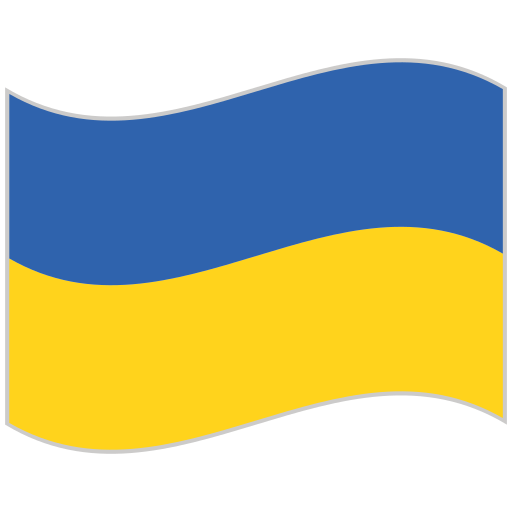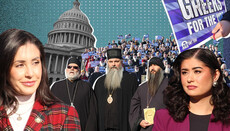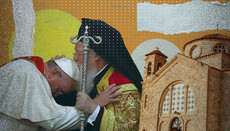Passions over Patriarch Alexy II’s Gramota
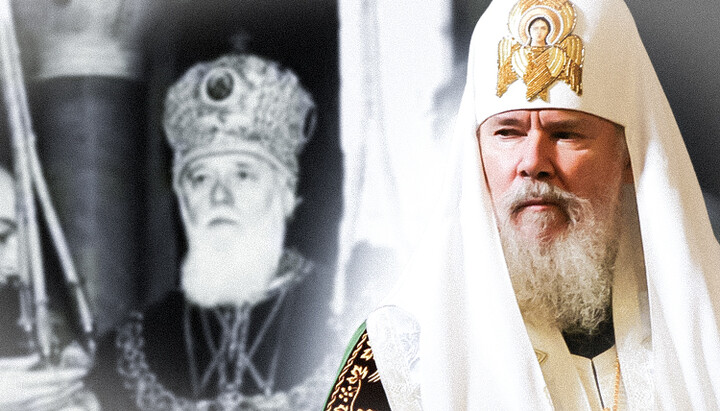
Some opponents of the UOC claim that the Gramota binds it to the ROC, while others say it forbids it from declaring independence. But what does it really say?
Patriarch Alexy’s 1990 Gramota granting the UOC independence in governance was always considered an internal Church document. Before the Euromaidan, no one even mentioned it. But today it has become the focus of intense scrutiny, manipulation, and even lies from the authorities. Let us therefore examine in detail what it actually says.
Before analyzing the text of the Gramota itself, we need to describe the political and religious context in which it appeared. The Gramota granting independence to the UOC appeared nearly a year before Ukraine declared independence. In other words, Ukraine did not yet exist as a state – there was only the Ukrainian Soviet Socialist Republic within the USSR – but an independent UOC already existed.
A rhetorical question immediately arises: does this indicate a pro-Russian or pro-Ukrainian orientation of the UOC? Of course, by 1990 the USSR was already on its last legs, and independence movements were surging in its republics. The independent UOC emerged as part of these broader trends. But there was another local factor: in western Ukraine, UOC communities were suffering real persecution from the revived Ukrainian Autocephalous Orthodox Church (UAOC) and even more from the Ukrainian Greek Catholic Church (UGCC). Churches were being seized en masse, and there were cases of violence and even stabbings. This gave the then-Metropolitan of Kyiv, Filaret (Denysenko), grounds to raise the question of transforming the Ukrainian Exarchate into an autonomous Ukrainian Orthodox Church.
On 25–27 October 1990, the ROC Bishops’ Council met in Moscow and decided to abolish the Ukrainian Exarchate and establish the UOC. Below I will summarize the main points of that decision, rephrased somewhat for clarity so readers can better appreciate its objective meaning at the time:
- The Church is granted independence and self-governance;
- The Primate is elected by that Church’s episcopate and blessed by the Patriarch;
- The Primate receives the title “His Beatitude”;
- The Primate is entitled to wear two panagias and carry the cross in services;
- The Church’s Synod elects and ordains ruling and vicar bishops, creates and dissolves dioceses;
- The Primate is a permanent member of the ROC Holy Synod.
What does that look like? One could say it is very close to full autocephaly – except for two points: the blessing of the newly elected UOC Primate by the Moscow Patriarch, and the Primate’s membership in the ROC Synod. The canons nowhere specify what rights an autocephalous Church has or how it differs from an autonomous one.
Historically, the main criterion of autocephaly was that the Primate was elected and ordained by local bishops, not sent from the “mother” Church. For example, when the Kyiv Metropolis belonged to the Ecumenical Patriarchate, the latter either sent a Greek bishop or ordained one brought to Constantinople by the local prince – often choosing among several candidates. The same principle applied when Kyiv joined the Moscow Patriarchate. In both cases, the decision was not made in Kyiv but in Constantinople or Moscow.
In the 1990 decision establishing the UOC, its Primate was elected and ordained in Kyiv by Ukrainian bishops – with no outside interference. That aligns with the ancient concept of autocephaly.
As for the Moscow Patriarch’s blessing of the newly elected Primate, nowhere is it specified what that blessing means. Is it mandatory for enthronement in Kyiv? What if the Patriarch refuses to give it? What if the UOC simply stops asking for it? These questions have no answers. So the phrase “The Primate of the Ukrainian Orthodox Church ... is blessed by His Holiness the Patriarch of Moscow and All Russia” cannot be interpreted as forbidding the election of a Primate without that blessing.
Similarly, the phrase “The Metropolitan of Kyiv and All Ukraine as Primate of the Ukrainian Orthodox Church is a permanent member of the Holy Synod of the Russian Orthodox Church” raises questions. What would happen if the UOC Primate simply left the ROC Synod? Nowhere is that explained. One thing is certain: leaving the Synod would not call into question the UOC’s existence as an independent Church.
In fact, historically, participation by patriarchs or bishops of Eastern Churches in the synodal bodies of the Ecumenical Patriarchate was common and did not indicate that those Churches were part of the Patriarchate.
Based on the decisions of the ROC Bishops’ Council of 25–27 October 1990, Patriarch Alexy II issued the Gramota we will now analyze. The text is short enough to quote in full:
"Gramota of Alexy II, by the grace of God Patriarch of Moscow and All Russia, to Metropolitan of Kyiv and All Ukraine Filaret
We, humble Alexy II, by the grace of God Patriarch of Moscow and All Russia, together with all the Right Reverend bishops of the Russian Orthodox Church – Moscow Patriarchate, gathered at the Bishops’ Council on 25–27 October 1990 at the Holy Danilov Monastery in the God-preserved city of Moscow, motivated by the desire for blessed peace, Christ’s covenantal love, and fraternal unity in common labor in God’s field with the entire fullness of the Ukrainian Orthodox Church, in view of the desire and petition of its Right Reverend archpastors who gathered on 9 July 1990 in the God-preserved city of Kyiv to discuss and decide their church life on principles of independence and self-governance,
– by this present Gramota bless with the power of the All-Holy and Life-Giving Spirit the Orthodox Ukrainian Church to be henceforth independent and self-governing in its administration, and you, unanimously elected on 9 July 1990 by the episcopate of the Ukrainian Orthodox Church, as its Primate. We trust that the Ukrainian Orthodox Church will be governed in accordance with the Divine and sacred canons and the customs inherited from the Holy Fathers of the Catholic Orthodox Church and the decisions of this Bishops’ Council. With one heart and one voice we pray to the Chief Shepherd, the Lord, to send heavenly help and blessing upon the Holy Orthodox Ukrainian Church.
The Ukrainian Orthodox Church, united through our Russian Orthodox Church with the One Holy Catholic and Apostolic Church, without the conciliar decision of the entire Orthodox Catholic Fullness, shall not change anything regarding the dogmas of the faith and the holy canons.
May the Creating and Almighty Life-Giving Trinity – Father, Son, and Holy Spirit – always strengthen the Holy Orthodox Ukrainian Church, crown it with glory and honor, and bless its existence for the salvation of its pious Fullness.
Signed in the city of Moscow on the 27th day of October, 1990.
ALEXY, Patriarch of Moscow and All Russia."
Patriarch Alexy II solemnly handed this Gramota to Metropolitan Filaret of Kyiv and All Ukraine on 28 October 1990 during the Divine Liturgy in St. Sophia Cathedral in Kyiv.
First, note the preamble: “...motivated by the desire for blessed peace, Christ’s covenantal love, and fraternal unity in common labor in God’s field with the entire fullness of the Ukrainian Orthodox Church.”
What did Patriarch Alexy II and the ROC seek in granting this Gramota? Peace, love, and unity in God’s work. Are there any words about the UOC remaining forever within the ROC? About unity meaning administrative subordination? About the UOC being required to obey ROC decisions? None of that appears.
And the UOC itself, before or after the 2022 Feofania Council, has in no way violated that aspiration to “peace, love, and unity in God’s field.”
The operative part repeats in essence the 1990 Council’s decision: “to be henceforth independent and self-governing in its administration...” – which effectively means actual autocephaly, since no restrictions are imposed except one, which we will discuss shortly. And that restriction applies to all Local Autocephalous Churches.
The Gramota lists the rules the UOC is to follow:
- The Divine and sacred canons, the customs inherited from the Holy Fathers of the Catholic Orthodox Church;
- The decisions of the ROC Bishops’ Council of 25–27 October 1990.
There can hardly be any objection to the UOC being guided by the sacred canons.
As for the Council’s decisions, as noted, they do not limit the UOC’s independence in any practical way.
However, the Gramota does contain one direct prohibition: “The Ukrainian Orthodox Church ... without the conciliar decision of the entire Orthodox Catholic Fullness shall not change anything regarding the dogmas of the faith and the holy canons.”
This is the same restriction all Local Orthodox Churches have. But for the UOC, it can also be understood to mean that it cannot unilaterally declare autocephaly without the approval of the “entire Orthodox Catholic Fullness.” While not stated explicitly, in today’s church context, that is a reasonable interpretation.
If one looks dispassionately at the UOC’s Feofania Council decisions of 27 May 2022, it is clear the UOC acted in full accordance with the Gramota’s requirements. On one hand, it exercised its right to full administrative independence (i.e., it does not belong to the ROC in any way), and on the other, it did not declare autocephaly unilaterally, since that requires the approval of the entire Orthodox Catholic Fullness.
The current status of the UOC is therefore transitional – waiting for the reception of its new status by the whole Orthodox Church. That could take years, even decades, given the complicated situation, the Ecumenical Patriarchate’s claims to primacy, its interventions in Ukraine, and its drive for union with the Catholic Church.
As Metropolitan Yevlogy of Sumy and Okhtyrka wrote on Facebook on 25 October 2023:
“The content of the new UOC statute testifies to a new status for the UOC as a canonically independent and self-governing Orthodox Church. ... In the future there must be reception of this status by the Local Orthodox Churches. ... Reception cannot happen instantly; it takes time. In my view, recognition of the new independent status of the UOC (the reception of the 27 May 2022 Council decision) may take place either at a Pan-Orthodox Council or at a meeting of all Primates of the Local Orthodox Churches (as happened, for example, in Bulgaria at the end of the 20th century). Declaring its new independent status, the UOC did not follow the path of schism but remained within the One Holy Catholic and Apostolic Church – something on which there is no doubt in any Local Orthodox Church.”
Finally, we cannot ignore the Gramota’s phrase that the UOC is “united through our Russian Orthodox Church with the One Holy Catholic and Apostolic Church.”
This is a rather odd construction, unknown to any canons or patristic tradition. In our view, this bit of “canonical creativity” was meant solely to solve the problem of how to distinguish “broad autonomy” from autocephaly. The wording turned out to be quite clumsy, as there is no canonical basis for such a relationship at all.
The Church is the Body of Christ. Any believer belongs to the Church by virtue of Baptism. Any bishop serves by virtue of his episcopal consecration. The relationship between a diocesan bishop and the Primate of a Local Church is defined by Apostolic Canon 34:
“The bishops of every nation must acknowledge him who is first among them and account him as their head, and do nothing of consequence without his consent; but each may do those things only which concern his own parish, and the country places which belong to it. But neither let him (who is the first) do anything without the consent of all; for so there will be unanimity, and God will be glorified through the Lord in the Holy Spirit..”
This says nothing about a bishop being “connected to the Church through the first among them.” On the contrary, it affirms the bishop’s right to govern his own diocese independently.
Moreover, the phrase about “connection through the ROC” fails to answer what happens if the UOC declares its belonging to the Orthodox Catholic Fullness directly, without the ROC. Would that mean breaking with the Orthodox Church? Clearly not.
In short, the Gramota of Patriarch Alexy II of 27 October 1990 in no way prevents the UOC from asserting its full independence and self-governance, from leaving the ROC, or from withdrawing its bishops from its governing bodies. That is the answer to those who accuse the UOC of schismatic actions or exceeding its authority.
As for those (mainly Ukrainian officials) who reproach the UOC for retaining mention of Patriarch Alexy II’s Gramota in its new statute as a kind of founding document – they should consider this:
Though the UOC traces its origins to the Kyiv Metropolis established at the Baptism of Rus in 988 under St. Prince Volodymyr, its current organizational form is also based on Patriarch Alexy II’s Gramota.
And here is the paradox – that Gramota is also the founding document for the OCU. Because what would rejecting that Gramota as void mean? That in 1992 Filaret (Denysenko) was not “His Beatitude Metropolitan of Kyiv and All Ukraine” but merely Metropolitan of Kyiv and Halych, Patriarchal Exarch of Ukraine. There was no UOC – only the Ukrainian Exarchate, which could not independently decide anything about its internal life.
It means Filaret had no right on 26 May 1992 to convene the so-called “All-Ukrainian Conference for the Defense of the Canonical Rights of the Ukrainian Orthodox Church” in Kyiv. He simply wasn’t entitled to do that – because he only claimed that right as the Primate of the UOC, not as head of the Exarchate.
Put simply, he based his authority precisely on this Gramota.
That means he also had no right on 25–26 June 1992 to gather a few UAOC bishops, MPs, and his residence staff and call it the “Unification Council of the UOC and UAOC,” at which those bodies were dissolved and the “Ukrainian Orthodox Church – Kyiv Patriarchate” was proclaimed.
In short, if you declare Patriarch Alexy II’s Gramota “null and void,” you must abolish the UOC-KP and the OCU, which was founded on its basis in 2018. If you nullify the ROC Bishops’ Council decisions of 25–27 October 1990 (on which the Gramota is based), then Filaret could not independently, without Moscow’s decision, ordain “bishops” – including Serhiy (Epifaniy) Dumenko. Of course, in reality he couldn’t anyway, since he was deposed and excommunicated – but that’s another matter.
Subjectively, he considered himself the Primate of the UOC. So let’s first ask the OCU how they view Patriarch Alexy II’s Gramota before reproaching the UOC for mentioning it in its new statute. As Filaret himself once said: “If I was under anathema, then Epifaniy isn’t even a priest.” By the same logic, if you reject Patriarch Alexy II’s Gramota, then Epifaniy isn’t a priest or bishop either.
In conclusion, let’s repeat once more: at least so far, the UOC has done everything – including the decisions of the Feofania Council – in full accordance with Patriarch Alexy II’s Gramota, the 1990 ROC Bishops’ Council decision, and the holy canons of the Church. And above all, it has done so “...motivated by the desire for blessed peace, Christ’s covenantal love, and fraternal unity in common labor in God’s field.”
